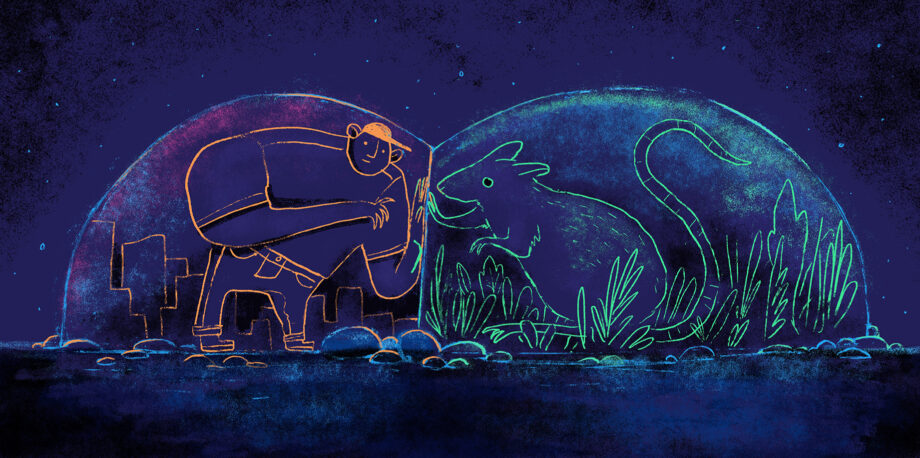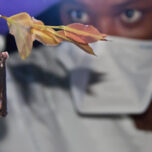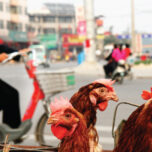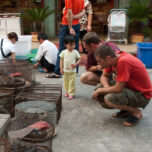April 7, 2020 — The COVID-19 coronavirus has catapulted across the ever-evolving interface between humans and wild places, generating global impact and alarm. Quarantines have been imposed, and borders have been closed. Free movement of people, the pursuit of normal daily routines, economic well-being — and in too many instances, health and even life itself — have been dramatically curtailed by a virus that previously lived beyond the pale and a disease that was unknown and unnamed only a few months ago.
What was immediately apparent was that the virus responsible for the outbreak had most likely originated in wild animals. It had “spilled” from its natural environment and ancestral host into the maelstrom of activity in an animal market, just as the virus responsible for SARS likely did in 2002. The COVID-19 virus breached natural boundaries at the interface between human activity and wild ecosystems.
Human spheres of activity and those of natural ecosystems may be seen like soap bubbles that contain pathogens. Initially, physical separation maintains these two spheres aloft without conflict. However, as the two move closer to one another, they develop an ever-increasing surface area of contact. Eventually, the bubbles merge and finally burst, releasing their contents. This, in effect, represents a “spillover” event.
If we are to reduce the likelihood of future spillovers of pathogens like the novel coronavirus, we need to adopt a comprehensive approach, centered on the integral role played by the interfaces.It is no small task to predict which of the millions of unknown pathogens in circulation will become “bad actors” in the future. But one thing is clear: A major factor driving such spillover events is the loss of natural boundaries between humans and wild ecosystems and the organisms that live in them. We have blindly consumed and traded wildlife while destroying wild places. Spillovers are likely to become regular occurrences unless we, as a world community, elect to change. If we are to reduce the likelihood of future spillovers of pathogens like the novel coronavirus, we need to adopt a comprehensive approach, centered on the integral role played by the interfaces.
This means, first of all, adopting and enforcing a global ban on commercial wildlife trade and unsustainable use of wildlife. That includes a permanent ban on commercial wild animal markets and consumption and should not neglect transactions for pets, “medicinal” and “research” purposes.
At the human scale, markets and trade in live wild animals in China and Southeast Asia represent super-interfaces, where a wide variety of species, many of which have been transported long distances, are caged and commingled. These multiple stressors inhibit animals’ immune responses and allow for enhanced shedding of pathogens. Stress also leads to increased excretion of saliva and voiding of urine and feces, all of which facilitate disease transmission.
But animals do not only transmit viruses among themselves. Vendors and customers circulate within this milieu, and slaughter and purchasing practices continually expose them as well. Hence, these markets provide ideal conditions for pathogen spillover.
Of course, there has been an extraordinary worldwide response to the emergence of the novel coronavirus. In China, where the virus originated, the government initially called for the temporary ban on the sale of wildlife in markets and restaurants and over e-commerce. It soon amplified its commitment by declaring a permanent ban on wildlife trade relating to consumption. However, loopholes that dilute its efficacy must be closed.
The value of keeping ecosystems that bump up against human activity intact cannot be overemphasized.We must also attend to the interfaces of wild ecosystems and human activity where spillover is a natural and predictable outcome. Here, we need to change behaviors and practices to mitigate human risk while minimizing ecosystem disruptions, allowing the environment to perform its innate buffering services. The value of keeping ecosystems that bump up against human activity intact cannot be overemphasized.
The COVID-19 pandemic is not the first spillover event to threaten human populations, and it will not be the last. Spillover events are likely to persist, and their unpredictable repercussions will be felt both physically and financially. Epidemics like COVID-19 affect society, economies and ecosystems. And while our attention may be distracted by short-term political concerns and conflicts, the root-cause derangement of natural interfaces within the ongoing global ecocide must not be lost. Now is the time to act to limit future harm.
Editor’s note: The views expressed here are those of the author and not necessarily of Ensia. We present them to further discussion around important topics. We encourage you to respond with a comment below, following our commenting guidelines, which can be found on this page. In addition, you might consider submitting a Voices piece of your own. See Ensia’s Contact page for submission guidelines.
Related Posts
Ensia shares solutions-focused stories free of charge through our online magazine and partner media. That means audiences around the world have ready access to stories that can — and do — help them shape a better future. If you value our work, please show your support today.
Yes, I'll support Ensia!




